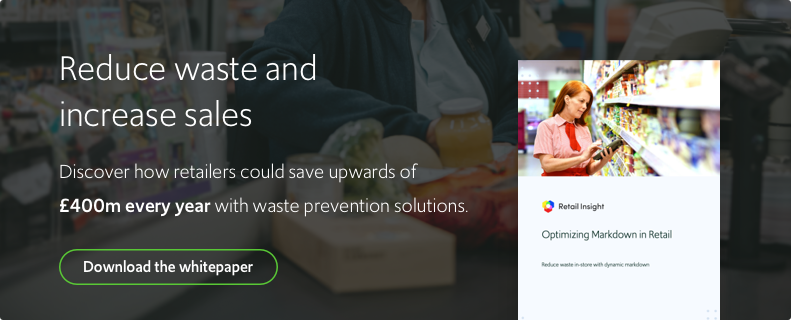
Preventing shrink in retail stores: Stock loss prevention strategies

- 5 minute read
- Retail Insight Team
Each year UK retailers lose more than £10bn to retail shrink and tackling this loss is far from straightforward. How should retailers define shrinkage in the first place? How can they calculate an acceptable shrinkage percentage? And what is the most effective stock loss action plan to protect their bottom line?
The importance of managing shrink in retail stores
Managing shrink in retail stores can be a highly complex balancing act. It is why after years of debate and discussion the industry is yet to agree upon a single shared definition of what shrinkage encapsulates.
That is because, many argue, it goes far beyond simply eliminating loss or minimizing theft. Yes, successfully managing shrinkage in stores requires protecting stock against any material losses to its value, but it also requires retailers to ensure they realize all potential value of the same stock. The difficulty is that these two dimensions can sometimes be at direct odds with one another.
The balancing act between the two can be summed up perfectly by the introduction of self-selection in grocery stores. After seeing the success of self-serve Piggly Wiggly stores in the US, Lord Sainsbury returned to the UK to convert the chain’s Croydon store to this model in 1950. From there the concept of consumers browsing stores and filling their own baskets boomed. At the same time, this shift exposed stores to far greater rates of shrinkage via theft of inventory and damage.
The model survived though because it created a better shopping environment, converting more visits to higher-value sales and cheaper to operate, thereby helping retailers realize more of the potential value in their stock. In short, grocers accepted actual loss, in order to avoid potential loss elsewhere.
This same strategic approach has accompanied self-scanning tills and the greater availability of fresh produce – both of which expose stores to greater shrinkage via theft, damage, and waste but which generate proportionately greater value via a more seamless, convenient shopping experience.
It is important to understand from the outset therefore that reducing shrinkage in retail requires a constant and careful balance of these two dimensions. Any effective stock loss prevention strategy must aim to reduce loss to the lowest possible levels without impacting the overall shopping and purchasing experience, i.e. without sacrificing any potential value.
1. Gather the right data and expertise
Measurement, collation, and comparison should be the starting points for any retailer looking to improve their own stock loss prevention strategy and this measurement should extend across all the various causes and contributors. That includes those that lead to a partial loss of value, such as stock damage, quality that fails to meet customer expectations, or inaccurate forecasting resulting in markdowns, and also those that lead to the elimination of all value from stock. Theft of inventory is often given the highest profile here – with £700m stolen from UK retailers in 2018, according to the BRC – but waste is also a major contributor in grocery, in particular across short-shelf life fresh produce and bakery.
Europe’s ECR recommends that retailers measure all these types of loss, at SKU or product Ievel, but also by individual store or area to identify the most vulnerable types of products and routes into retail. An overall stock take and look at shrink in retail stores should be undertaken at least twice per year, the working group adds, though it will of course require integration into daily processes too.
Once gathered, this data can be shared between retailers in order to get a clear and accurate view on acceptable levels of shrinkage, and also to understand where prevention strategies can be most effectively applied. Calculating shrinkage rates as a percentage of turnover is one of the most common ways of doing this, allowing retailers to facilitate comparison without sharing commercially sensitive figures. Doing so allowed a 2019 study across UK grocers to come up with an average shrinkage rate of 2% across all stores.
Armed with a clearer view of both their individual levels of shrinkage and where this sits within an industry context, retailers should be able to build up a picture of where their shrink reduction efforts are most needed.
2. Adopt a systematic approach to management
Whichever cause of retail shrink they decide to focus on though, it is important to adopt a systemic take on management.
Take the example of a case of wine dropped by a member of staff while restocking shelves. It might appear at first glance that simply coaching the individual is all that is required to prevent future loss. A systemic look at the causes though might uncover inadequate training on how to carry out the task, stretched resources leading the staff member to carry out the task in a hurry, or poor forecasting leading to a need to restock at peak periods.
By looking at shrinkage in this systemic way, retailers can do a far better job of preventing future incidents in the long term. It is an approach that can be applied universally to all types of shrinkage too. Take the second example of a stolen bottle of spirits. Systemic causes could include everything from the positioning of vulnerable stock close to the entrance, i.e. store layout, to poor store security and surveillance, to inadequate staffing or training, which meant suspicious behavior went unnoticed or unchallenged.
By building up methodical insights into all the products, processes, people, locations, and times that surround and accompany shrinkage, retailers can build an effective strategy both for prevention and also for accurately predicting shrinkage in the future. Some element of shrinkage in the retail environment is inevitable and so accurate predictions of potential loss, informed by this granular data, ensures no retailer should be left staring at a surprise black hole in their accounts at the end of the financial year. In this way tackling shrinkage truly does require adherence to the old adage that retail is detail.
This same rich data will also allow a more forensic cost vs. benefit analysis when it comes to making changes in stores to acquire greater value from stock, i.e. is the potential value gained by a change outweighed by the actual loss? We know, for example, that self-scanning tills can increase losses via shrinkage by between 30-70% in stores. But retailers have determined their benefits in creating a leaner in-store operating model and more convenient shopping experience outweigh this loss.
That type of nuanced conclusion is only possible though when armed with clear, granular detail on all the different types and causes of shrink in retail stores in the first instance. Data does, in other words, make the balancing act just a little more manageable.
Get in touch
Written by Retail Insight Team
Retail Insight takes data and turns it into action. Our advanced algorithms unlock valuable insights that drive better decision-making for retailers and CPGs.
You might be interested in


How to reduce retail shrink and pinpoint the root cause

Using decision science to predict fair retail shrink targets

Shoppers still plagued by out-of-stocks

Physical stores are the key to grocery ecommerce success

Why do grocery retailers find on-shelf availability such a challenge?

How tech and connectivity can transform the role of store associates

How can retailers optimize their space and assortments post-COVID-19?

Unveiling the true cost of inventory inaccuracy

Rethink Shrink | The impact of a bad count

How to maximize retail labor productivity


